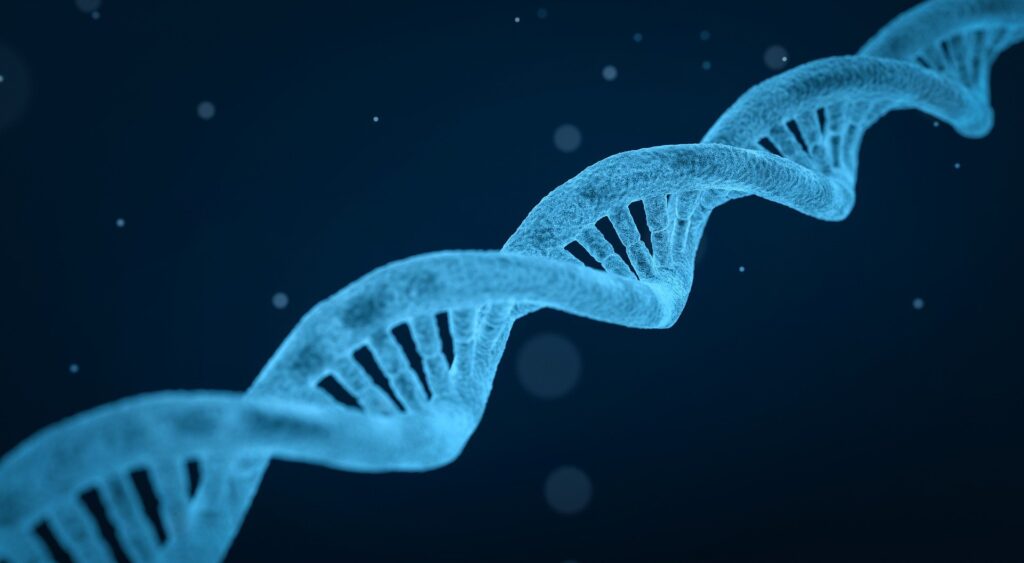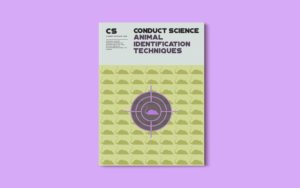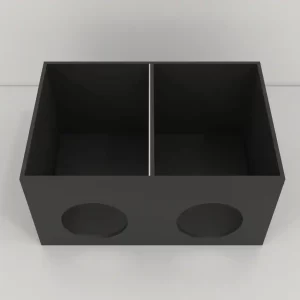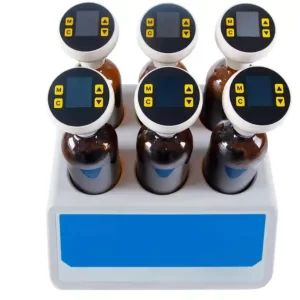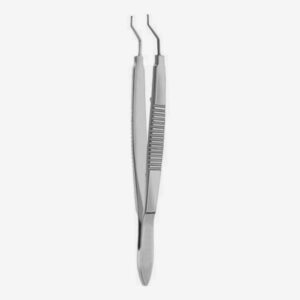Introduction and Principle
Insertion of foreign DNA into M13 cloning vectors is a bit tricky and includes the following steps:
- Ligating double-stranded DNA segments with cohesive termini into compatible sites in M13 double-stranded RF DNA.
- Transforming ligation products into competent male E. coli cells (plated in top agar supplemented with X-gal and IPTG.
- Picking and propagating recombinant (white) and non-recombinant (blue) M13 phages appear after 6 to 8 hours of incubation.
The blue/white test serves as the best indicator, but it is not foolproof. Only a few recombinant viral strains possess the ability to form blue plaques. Such recombinants possess a very small amount of foreign DNA (less than 100 bases), and the foreign DNA is inserted within the LacZ sequence of the vector. The fusion peptide formed, as a result, retains enough α-complementing activity to impart blue color to the plaques in a media having IPTG and X-gal.
There is no hard and fast rule regarding the size of a foreign insert. However, there are a few constraints due to which the inserts of smaller size are preferred. For instance, foreign DNA of larger size is at a risk of facing deletions and rearrangements. Therefore, the insert must be no longer than 1000 bases in length. Similarly, the central region of a foreign DNA fragment of larger size might linger outside the range of forward and reverse primers used in DNA sequencing reactions. One can avoid these problems by taking the following measures:
- Keep the insert size as small as possible.
- Do not propagate the phages for more than one or two serial passages in the culture.
- Recover the foreign DNA fragments from M13 vectors immediately after site-directed mutagenesis.
We can employ any of the following methods for generating M13 cloning vectors.
Ligating the insert to linearized vector
A single restriction endonuclease is used to leave a site within the polylinker region (MCS) of the vector generating a linear DNA fragment. This DNA is ligated with a three to five-fold molar excess of foreign DNA having compatible termini. Meanwhile, the formation of chimeric clones is not suppressed, and no heed is paid to lessen the background of non-recombinant phages formed by the recircularization of the vector. This method serves best to produce single-stranded DNA for site-directed mutagenesis, radiolabeled probe synthesis, and DNA sequencing.
Recombinant M13 bacteriophages can carry the foreign DNA sequences in two possible orientations. However, they are mostly carried in the same orientation. This phenomenon mainly arises when opposite strands of foreign DNA interfere with the intergenic region to a varying degree. To overcome this problem, clone the foreign DNA at a different site in the polylinker region (MCS). Otherwise, digest the double-stranded RF DNA from the original recombinant with the restriction endonuclease used for cloning, religate it and then use it to transform E. coli. Screening of the subsequent white plaques might reveal the clones carrying DNA in the opposite orientation. However, it is not advised to force M13 recombinants to proceed with ‘unwelcome’ foreign DNA sequences. Moreover, these recombinants are unstable and yield progeny having deleted or rearranged foreign sequences. To overcome this issue, use those plasmid vectors for foreign DNA propagation that possess a filamentous phage-derived origin of replication.
Alkaline Phosphatase Treatment of foreign DNA
The vector DNA is treated with a single restriction enzyme to linearize it. We can reduce the recircularization ability of the linearized DNA by dephosphorylating the vector (Dale and Greenaway, 1984). This dephosphorylation also increases the proportion of recombinant clones. This method is selected when the amount of foreign DNA is limiting, or blunt-ended DNA fragments are to be ligated into bacteriophage M13 vectors, e.g., when subcloning M13 for generating libraries (Green and Sambrook, 2020).
Directional/ Forced Cloning
With hundreds of commercially available enzymes, the restriction digestion of insert and vector DNA, followed by ligation and transformation into competent E. coli cells, remains the standard procedure today. In the directional cloning method, a pair of restriction enzymes are used to cleave the multiple cloning site (MCS), creating fragments with incompatible termini (Baumann, 2013). These DNA fragments do not need to be dephosphorylated. The vector DNA is joined to the foreign DNA (having termini compatible with the vector). This method serves best while cloning a single foreign DNA segment into M13 in the desired orientation. However, this method is not suitable for the construction of large M13 libraries or cosmids. This strategy also seems to be a problem when using single-stranded DNA templates in radiolabeled strand-specific probe synthesis or sequencing. The sequences obtained by this method must be 200-700 nucleotides immediately downstream of the primer binding site. Radiolabeled probes will bind to only one strand of DNA. To avoid this problem, introduce the foreign insert separately into each member of the pair of M13 vectors carrying polyclonal sites in opposite directions. Single-stranded DNA templates generated by this method produce terminal sequences of both strands of foreign DNA, and radiolabeled probes show specific binding to either strand of foreign DNA.
Materials
Buffers, Enzymes, and Solutions
Gels and Media
- 0.8% agarose gel cast in 1x TBE having 0.5x Ethidium Bromide
- LB/ YT medium
- LB/ YT top agarose
- LB/ YT agar plates
Bacterial and Viral Strains
- E. coli strain carrying F’ plasmid
- Bacteriophage M13 vector DNA
- Competent E. coli carrying F’ plasmid
Nucleic Acids
Other Equipment
Methods
Vector DNA Preparation
- Take 1-2ꭒg of M13 double-stranded RF DNA and completely digest it with three to five-fold excess of suitable restriction endonucleases. Also, set up a control reaction containing M13 RF DNA only without restriction enzyme.
- Remove a small aliquot (about 50ng) from each reaction after incubation and perform 0.8% agarose gel electrophoresis to analyze the magnitude of digestion. Add more restriction enzymes if the digestion is incomplete and continue incubation.
- When the digestion is complete, extract M13 DNA with phenol: chloroform for purification and then subject to ethanol precipitation in the presence of 0.3M sodium acetate. Add the DNA in TE (pH 8.0) at a concentration of 50ꭒg/ml.
- Treat the linearized vector DNA with calf/shrimp alkaline phosphatase for dephosphorylation. At the end of the reaction, inactivate the enzyme by heat or proteinase K digestion. Perform phenol: chloroform extraction at the end.
- Repeat step 3 to recover linearized DNA and dissolve it in TE (pH 7.6) at a concentration of 50ꭒg/ml.
Foreign DNA (to be cloned) Preparation
- Cleave the foreign DNA with appropriate restriction enzymes to get desired restriction fragments and then purify these fragments by agarose gel electrophoresis. Dissolve this foreign DNA in TE (pH 7.6) at a concentration of 50ꭒg//ml.
Ligation
You need to follow the given ligation steps if you are working with complementary cohesive termini.
- Take a microfuge tube, labeled as tube A, and add 50ng of DNA sample to it. Now add one to fivefold molar excess of the target DNA fragment such that the combined volume of two DNA must not surpass 8ꭒl. If necessary, adjust the volume to 7.5-8.0ꭒl by adding TE (pH 7.6). Also, add three controls. A tube B, without foreign DNA but having the same amount of vector DNA. A tube C, with the same amount of vector DNA and one-to-five fold molar excess of foreign DNA fragment. And a tube D, with the same amount of M13 DNA and an equal amount of foreign DNA (by weight), successfully been cloned previously into M13 vectors earlier.
- As test DNA, use standard bacteriophage lambda DNA preparation subjected to restriction digestion by enzymes that identify tetranucleotide sequences and produce termini, complementary to M13 vectors in use.
- Add 1ꭒl of 10x ligation buffer to all four tubes from A to D. Add 1ꭒl of 10mM ATP if the ligation buffer does not contain any. Otherwise, do not add ATP.
- Add 0.5 Weiss units of phage T4 DNA ligase to tubes A, B and D. Gently tap the sides of the tubes to mix their contents. Now incubate the tubes at 12-16oC for 4 to 16 hours. After incubation, perform 0.8% agarose gel electrophoresis using 1ꭒl of the sample for analysis. You will observe bands of circular recombinant DNA in the test reaction ‘tube A’ but no bands in the control reaction present in ‘tube C.’
- Store the reactions at -20oC until transformation.
Transformation
- Grow an overnight E. coli culture (plating bacteria) at 37oC in LB medium with constant agitation.
- Take an aliquot of the desired frozen competent cells (frozen at -70oC) having an F’ plasmid. Wait until the cells thaw and incubate on ice for 10 minutes.
- Take 16 sterile 5ml tubes and add 50-100ꭒl of competent cells with F’ cells (cooled down to 0oC) to each of the tubes.
- Now, add 0.1, 0.5, and 5ꭒl aliquots of ligation and control reactions from tubes A, B, C, and D spontaneously to the discrete tubes of competent cells. Gently tap the sides of the tubes a few times to mix the contents and then incubate on ice for about half an hour. Take two ‘transformation controls,’ i.e., a tube having 5pg of M13 double-stranded RF DNA and another without DNA.
- Allow the ligated DNA to incubate with the competent cells. Meanwhile, take 3ml of pre-warmed LB/YT top agar. Store the tubes in a water bath preset to 47oC or a heating block at the same temperature until wanted.
- Shift the tubes having competent bacteria to a water bath set to 42oC. Incubate the tubes for an exact one and a half minutes (90 seconds). Immediately return the tubes to ice.
Plating the cells after transformation
- Take the tubes with melted top agar/agarose and add 200ꭒl of E. coli cultures grown overnight along with 40ꭒl of 2% X-gal and 4ꭒl f 20% IPTG vortex for a few seconds to mix. Transfer each bacterial sample to the tubes. Close the lids of the tubes and mix the contents by inverting the tubes three times. Pour the contents of the tube into the agar plate and then swirl the plate to distribute bacteria and top agar evenly.
- Close the lids of the plates and let them rest for 5 minutes to allow the agarose to harden at room temperature. Wipe off the lid to remove any condensation and then invert the plates and incubate them at 37oC. Incubate the tubes for 8 to 12 hours until the plaques are formed. Non-recombinant M13 phages are from deep blue plaques, whereas the recombinants are from colorless plaques.
Summary
- The recombinant M13 bacteriophages are distinguished from non-recombinants by the blue/white plaque test.
- The size of the foreign insert must be kept smaller to avoid problems during cloning.
- Different methods are used for cloning foreign DNA into M13 vectors.
- Ligating the insert into a linearized M13 vector
- Dephosphorylation with an enzyme (alkaline phosphatase)
- Forced or directional cloning
- With hundreds of commercially available enzymes, the restriction digestion of insert and vector DNA, followed by ligation and transformation into competent E. coli cells, remains the standard procedure today.
References
- Sambrook, J., & Russell, D. W. (2006). Cloning into Bacteriophage M13 Vectors. Cold Spring Harbor Protocols, 2006(1), PDB-prot4018.
- Baumann, T., Arndt, K. M., & Müller, K. M. (2013). Directional cloning of DNA fragments using deoxyinosine-containing oligonucleotides and endonuclease V. BMC biotechnology, 13(1), 1-11.
- Green, M. R., & Sambrook, J. (2020). Dephosphorylation of DNA Fragments with Alkaline Phosphatase. Cold Spring Harbor Protocols, 2020(8), pdb-prot100669.
- Dale, J. W., & Greenaway, P. J. (1984). The Use of Alkaline Phosphatase to Prevent Vector Regeneration. In Nucleic Acids (pp. 231-236). Humana Press.


